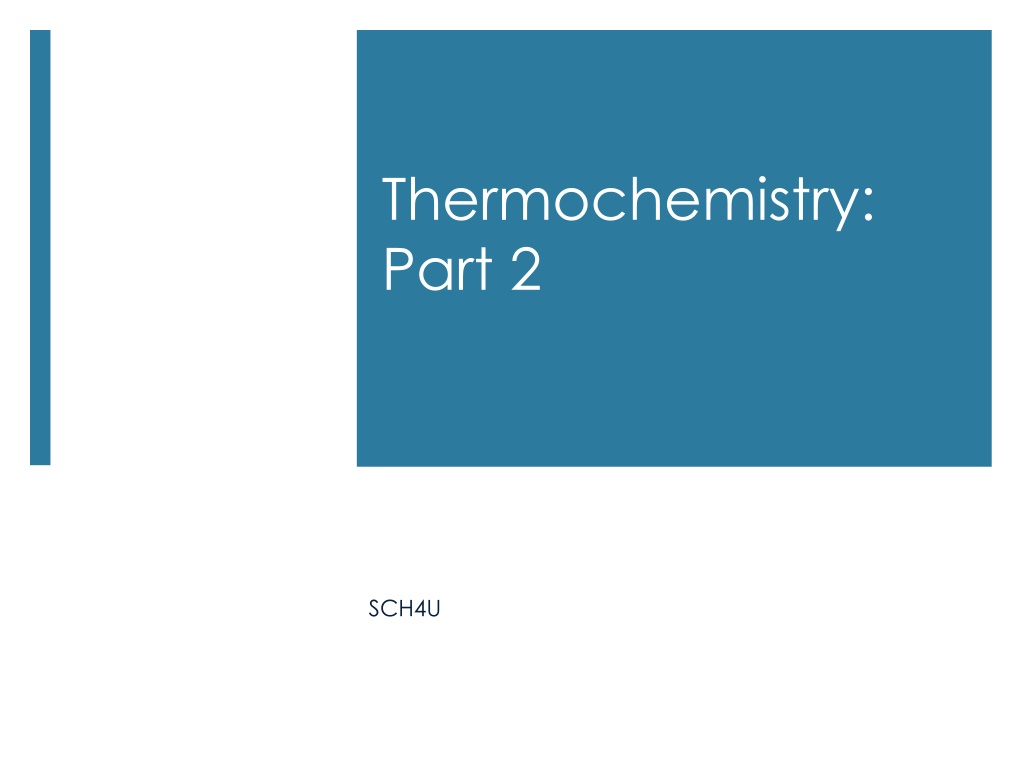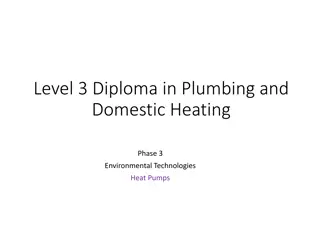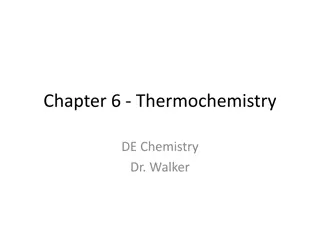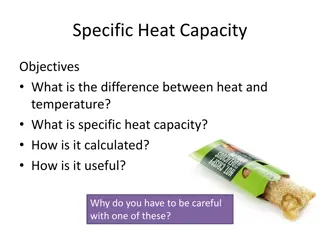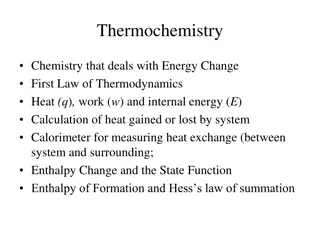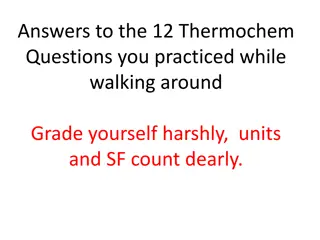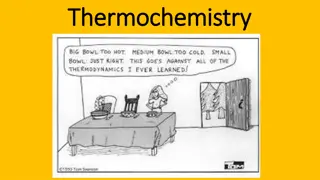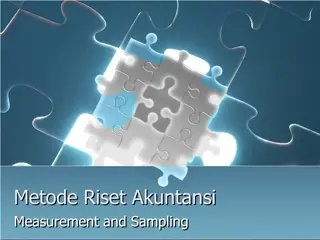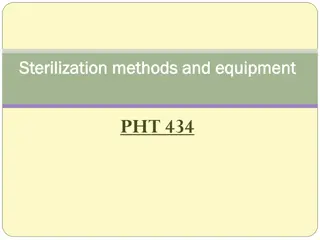Understanding Thermochemistry: Heat, Physical Changes, and Methods of Measurement
Thermochemistry delves into heat, physical changes, and various methods of measuring enthalpy, including calorimetry, Hess's Law, standard enthalpy of formation, and bond energies. Specific heat capacity is crucial for determining the amount of heat absorbed or released during a temperature change. Explore examples illustrating heat calculations with water, steam, and solid substances.
Download Presentation

Please find below an Image/Link to download the presentation.
The content on the website is provided AS IS for your information and personal use only. It may not be sold, licensed, or shared on other websites without obtaining consent from the author. Download presentation by click this link. If you encounter any issues during the download, it is possible that the publisher has removed the file from their server.
E N D
Presentation Transcript
Thermochemistry: Part 2 SCH4U
Heat and Physical Changes Hvap= - Hcond Hmelt= - hfre
3 Common Molar Enthalpies
Methods of Measuring H 1. Calorimetry (experimental) 2. Hess s Law: using Standard Enthalpy of Reaction ( Hrxn) of a series of reaction steps (indirect method). 3. Standard Enthalpy of Formation ( Hf ) used with Hess s Law (direct method) 4. Bond Energies used with Hess s Law
Specific Heat Capacity the amount of heat (Q) required to raise the temperature of one gram (1g) of the substance by one degree Celsius. ( 1C)
Heat (Q) absorbed or released Q=mc T Q= amount of heat transferred (Joules, J) m= mass of a substance (g) c= specific heat capacity (J/g 0C) T = Tfinal Tinitial (change in temperature) ( 0C)
Heat Examples 1) When a 1.25kg sample of water was heated in a kettle, its temperature increased from 16.40C to 98.90C. How much heat did the water absorb?
Heat Examples 1) When a 1.25kg sample of water was heated in a kettle, its temperature increased from 16.40C to 98.90C. How much heat did the water absorb? Q= 1.25x103g x 4.18 J/g0C x (+82.50C ) = 432 093.75 J = 4.32x105 J
Heat Examples 2) How much heat must be added to 128.62 g of steam at 126.00C to increase its temperature to 189.50C? 3) A solid substance has a mass of 250.0g. It is cooled by 25.000C and loses 4.937kJ of heat. What is the specific heat capacity of the substance?
Heat Examples 2) How much heat must be added to 128.62g of steam at 126.00C to increase its temperature to 189.50C? Q = 128.62 gx 2.02J/g0Cx (189.5-126.0) 0C = 1.65x104 J 3) A solid substance has a mass of 250.0g. It is cooled by 25.000C and loses 4.937kJ of heat. What is the specific heat capacity of the substance? c= Q/m( T) c= -4.937x103J/(250.0 g (-25.000C)) c= 0.7899 J/g0C
Additional Examples 1) How much heat is released when the temperature of 789g of liquid ammonia decreases from 82.70C to 25.00C? 2) On a warm day, how much solar energy does a 3.982kg piece of concrete absorb as heat if its temperature increases from 13.600C to 14.500C
Additional Examples 1) How much heat is released when the temperature of 789g of liquid ammonia decreases from 82.70C to 25.00C? Q= mc T = 789 g x 4.70 J/g0C x (25.0-82.7) = - 213968.91 J change to -2.14 x105 J 2) On a warm day, how much solar energy does a 3.982kg piece of concrete absorb as heat if its temperature increases from 13.600C to 14.500C? Q= 3982 g x 0.88 J/g0C x (14.50-13.60) = 3153.744 J change to 3.2 x103J
Measuring Q experimentally Calorimeter a device that is used to measure enthalpy changes for chemical and physical reactions. Qreactions = - Q insulatedsystem
UNIT 3 Using Flame Calorimetry To Determine the Enthalpy of Combustion Chapter 5: Energy Changes Section 5.2 Flame calorimeters are flame-resistant and often made of metals cans A flame calorimeter is used for determining Hcomb absorbs a great deal of energy, which must be included in energy calculations is used for burning impure materials like food; Hcomb is reported in kJ/g
UNIT 3 Using Bomb Calorimetry To Measure Enthalpy Changes during Combustion Chapter 5: Energy Changes Section 5.2 A bomb calorimeter is used for more accurately determining Hcomb determines Hcomb at constant volume has a particular heat capacity, C Q = C T is used for bomb calorimetry calculations Bomb calorimeters are much more sophisticated than flame calorimeters or simple calorimeters.
UNIT 3 Chapter 5: Energy Changes Section 5.2 Using a Simple Calorimeter Constant-Pressure Calorimeter No boundary between system and surroundings Reactants and products are system, and water in which they dissolve in, is part of the surroundings the change in temperature of the water is measured; the solution absorbs or releases energy the solution is dilute enough so that the specific heat capacity of water is used Thermometer Styrofoam cover Styrofoam cups Stirrer
Practice #2 240 g of water (initially at 20oC) are mixed with an unknown mass of iron (initially at 500oC). When thermal equilibrium is reached, the system has a temperature of 42oC. Find the mass of the iron.
240 g of water (initially at 20oC) are mixed with an unknown mass of iron (initially at 500oC). When thermal equilibrium is reached, the system has a temperature of 42oC. Find the mass of the iron. T = 500oC mass = ? grams Fe T = 20oC mass = 240 g - LOSE heat = GAIN heat - [(Cp,Fe) (mass) ( T)] = (Cp,H2O) (mass) ( T) - [(0.4495 J/goC) (X g) (42oC - 500oC)] = (4.184 J/goC) (240 g) (42oC - 20oC)] - [(0.4495) (X) (-458)] = (4.184) (240 g) (22) Drop Units: 205.9 X = 22091 X = 107.3 g Fe Calorimetry Problems 2 question #5
Practice #3 A 97 g sample of gold at 785oC is dropped into 323 g of water, which has an initial temperature of 15oC. If gold has a specific heat of 0.129 J/goC, what is the final temperature of the mixture? Assume that the gold experiences no change in state of matter.
A 97 g sample of gold at 785oC is dropped into 323 g of water, which has an initial temperature of 15oC. If gold has a specific heat of 0.129 J/goC, what is the final temperature of the mixture? Assume that the gold experiences no change in state of matter. T = 785oC mass = 97 g Au T = 15oC mass = 323 g - LOSE heat = GAIN heat - [(Cp,Au) (mass) ( T)] = (Cp,H2O) (mass) ( T) - [(0.129 J/goC) (97 g) (Tf - 785oC)] = (4.184 J/goC) (323 g) (Tf - 15oC)] Drop Units: - [(12.5) (Tf - 785oC)] = (1.35 x 103) (Tf - 15oC)] -12.5 Tf + 9.82 x 103 = 1.35 x 103 Tf - 2.02 x 104 3 x 104 = 1.36 x 103 Tf Tf = 22.1oC Calorimetry Problems 2 question #8
Practice #4 If 59 g of water at 13oC are mixed with 87 g of water at 72oC, find the final temperature of the system.
If 59 g of water at 13oC are mixed with 87 g of water at 72oC, find the final temperature of the system. T = 72oC mass = 87 g T = 13oC mass = 59 g - LOSE heat = GAIN heat - [(Cp,H2O) (mass) ( T)] = (Cp,H2O) (mass) ( T) - [(4.184 J/goC) (87 g) (Tf - 72oC)] = (4.184 J/goC) (59 g) (Tf - 13oC) Drop Units: - [(364.0) (Tf - 72oC)] = (246.8) (Tf - 13oC) -364 Tf + 26208 = 246.8 Tf - 3208 29416 = 610.8 Tf Tf = 48.2oC Calorimetry Problems 2 question #9
Practice #5 A 322 g sample of lead (specific heat = 0.138 J/goC) is placed into 264 g of water at 25oC. If the system's final temperature is 46oC, what was the initial temperature of the lead?
A 322 g sample of lead (specific heat = 0.138 J/goC) is placed into 264 g of water at 25oC. If the system's final temperature is 46oC, what was the initial temperature of the lead? T = ? oC mass = 322 g Pb Ti = 25oC mass = 264 g Tf = 46oC Pb - LOSE heat = GAIN heat - [(Cp,Pb) (mass) ( T)] = (Cp,H2O) (mass) ( T) - [(0.138 J/goC) (322 g) (46oC - Ti)] = (4.184 J/goC) (264 g) (46oC- 25oC)] Drop Units: - [(44.44) (46oC - Ti)] = (1104.6) (21oC)] - 2044 + 44.44 Ti = 23197 44.44 Ti = 25241 Ti = 568oC Calorimetry Problem
26 Molar Enthalpy Change Hn: Molar Enthalpy Change ( Hn): enthalpy change associated with anychange (physical, chemical or nuclear) in one mole of a substance; J/mol or kJ/mol Hrxn = n Hn
27 Example: Ethanol is used to disinfect skin before receiving a flu shot. How does this feel on your skin? The enthalpy of vaporization ( Hvap)of ethanol is 38.6 kJ/mol. What is the enthalpy change ( Hrxn) of this reaction if 1.0g of ethanol is rubbed on your skin?
